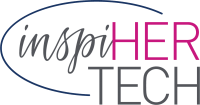

This month is all about the online job posting that you create from your internal job descriptions. Job postings are often the first way a potential employee becomes aware of your company.
Your job post can intrigue, invite and engage someone who may have never heard of your company. It can get them to take action and send off their resume.
Or it can turn that superstar female software engineer off in 15 seconds flat.
Words matter and building an inclusive IT team means attracting more women in tech.
Read on and learn the top 3 things you can focus on and simple, yet high-impact action steps, you can take TODAY to increase the possibility of more women applying to your open IT jobs.
Be InspiHERed!

CEO | Founder of InspiHER Tech, a Laso Company
P.S. Do you want your women in tech to be a formidable force within your organization? Then have them join me at InspiHER Tech’s monthly meetup where they can be a part of a community of Chicago Women in Tech – moving the needle for women succeeding and staying in technology careers.
Learn more about our monthly meeting.

Three Keys to Writing an Inclusive Online Job Posting
How important is an inclusive job post to filling a critical position?
VERY, VERY important. The all caps here are deserved.
“Job descriptions are way more than a formal document to get the recruiting process started,” says Kat Boogaard in The Muse. “Candidates take them very seriously.”
For the candidates who click “SUBMIT” on your application to come from a diverse talent pool, the job description needs to be inclusive: a thoughtful, engaging and universally appealing description that helps all your potential candidates feel welcome.
There are dozens of tips, apps and e-books that teach the basics of writing an inclusive job post. Here we’ve distilled that advice for you in three key actionable items: words, requirements, and culture.
1. Words
Neutral words can increase your job applicants by 42%, says Zip Recruiter. Job titles with gender-coded words such as “hacker,” “rockstar,” and “ninja” can be an immediate turn- off for women applicants. Straightforward titles such as “developer,” “analyst,” or “project manager” avoid gender implications. Elsewhere in a description, strive for neutral terms or at least balance typical masculine wording (dominant, superior, aggressive) with words that tend to carry a stronger feminine association (interpersonal, responsible, trust).
Action: Analyze your job descriptions with online tools like: Textio or Gender Decoder for Job Ads.
2. Requirements
A quick bit of top-line research on how candidates interpret the list of qualifications in a job posting turns up the same stat over and over: Men will apply for a job when they meet 60 percent of the qualifications. Women tend to apply only when they meet 100 percent.
Maxwell Huppert, writing for the LinkedIn Talent Blog, recommends that the best solution is to “stick to the must-haves” and either eliminate or soften the “nice-to-haves.” He suggests using phrases like “familiarity with” or “bonus points for” if you’re including additional criteria. You can also highlight skills that can be learned on the job instead of emphasizing more restrictive qualifications such as a specific field of study, highly specialized technology, or exact number years of experience.
Action: To hit the sweet spot between the musts and the nice-to haves, ask your employees for input on how to remove criteria that are not truly necessary for a job, and for ideas on how you can make your description more inviting and engaging.
3. Culture
A more diverse set of candidates will apply to your job posting if it reveals an inclusive culture with a corporate mission and values that emphasize a strong sense of belonging for all.
Actions:
- Feature your company’s complete mission statement on commitment to diversity and inclusion.
- List inclusive benefits such as parental leave, childcare subsidies, or paid family sick time.
- Note if you have inclusion-friendly programs such as formal mentorship programs for women and minorities or employee resource groups.
- Ensure that any graphics, photos or videos that accompany a job posting or are featured on your website include a diverse range of people, preferably those already working at your company.
People-first hiring
If you’re building an inclusive workplace, you want your job postings to reflect that in every way: wording, requirements, and the presentation of your corporate vibe. It’s “people-first hiring” that helps you reach a wider pool of applicants, improve the diversity of those applicants, and ultimately hire great employees who will help make your workplace a more inclusive place to thrive.

Words matter: here are 17 that could be turning women away from your jobs. [LinkedIn Talent Blog]
Ground-breaking research in 2011 showed that gendered wording in job ads exists and sustains gender inequality. [Journal of Personality and Social Psychology]
Why Women Don’t Apply for Jobs Unless They’re 100% Qualified. [Harvard Business Review]
The CEO of the Network of Executive Women weighs in on inclusive job descriptions. [Convenience Store News]

“If you exclude 50% of the talent pool, it’s no wonder you find yourself in a war for talent.”
Theresa J. Whitmarsh, Executive Director of the Washington State Investment Board, commenting at the 2016 World Economic Forum annual meeting, Davos, Switzerland
